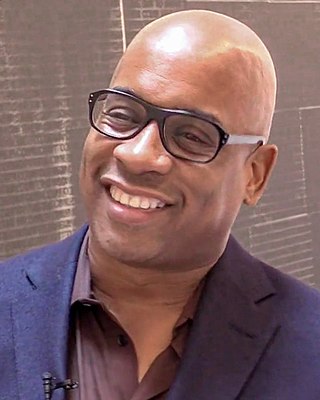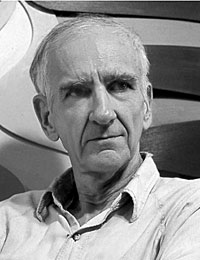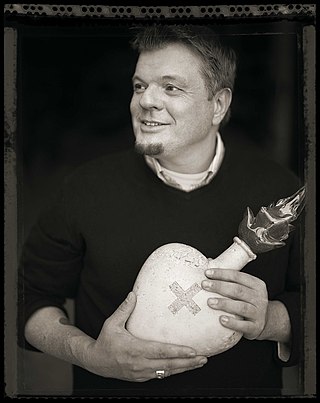Works
Early works
In the beginning of his career, Kraft worked with modeling the figure in clay, using traditional methods and traditional subjects. But, by the early 1980s he began to find his work becoming monotonous, and looked towards the newly opened American School of Neon in Minneapolis, MN for inspiration. The philosophy of the school was to treat neon as a sculptural medium rather than merely a medium for commercial signage. Kraft was able to manipulate the neon in order to integrate it with his fragmented, sequenced figurative work. The colored lights added a certain volume, experience, and mood to the work that Kraft found previously lacking.
Many of these early works feature sections of plaster casts of models attached to canvas, backlit with neon. Kraft enjoyed "the personal aspect of body casting, and the shared beauty of the certain aspect of the human form and condition." [3] The neon tubing is often concealed in his sculptures, either by hiding the tube within the cast or by painting the tube black and scratching out sections of paint to direct the flow of light onto the figures, giving the sculpture the appearance of a mysterious colored glow. Of Kraft's early work, "a common theme…a theme that immediately holds a peruser's eyes hostage—is the seemingly partial emergence of a human figure from the canvas, made all the more captivating by the strategically placed neon backlighting that appears to serve as the portal for the bas-relief segment of the work." [7]
Kraft is currently “one of only a handful of light artists in the world who bends his own glass and is respected for his ability to precisely manipulate the figure and light to capture his own artistic vision." [8]
Career


Krafts career then dove into an 8-year inquiry into the universal urge to connect through mark making. [9] It started in 2009 with a series called Unintentional Drawings and progressed to the omnipresent graffiti on the walls of the Ground Zero Blues Club in Clarksdale Mississippi.
This urge to mark inspired him to travel to 3 continents and visit 27 ancient cave sites in Southern Europe, Indonesia [10] and Africa to view, first hand, the first drawings, paintings, and etchings made by early homo sapiens from up to 40,000 BC. He was particularly drawn to what are referred to as "signs" or symbols which may be the earliest known marks of all. The experiences that he had within the caves has led his artistic career to investigate modern and ancient symbols as well as paint and draw images combined with the same type of flickering light- dots and hand stencils.
In 2017 he traveled to the Kalahari Desert of Namibia, where he met the Sans, the oldest indigenous group in the world. Months after returning from Africa, Kraft realized that the safari directly exposed him to the sacred animals which the Sans had worshipped. The most powerful to him was the elephant. He then proceeded to sculpt, in light, the spirit of the African elephant-half size- in a light blue-silvery neon. During this creative process, the spirit of the African elephant evolved into the Damaged spirit of the African elephant, visually illustrating the horrific poaching of elephants tusks occurring around the world.
Public art
When asked why he began to work in large-scale public art by Washington, DC local news reporter Holly Morris, Kraft responded that he wanted to be able to draw on buildings with neon, and that when drawing in space with light one needs to be able to work much larger. [11] Many of his public art pieces appear to do just this. Lightweb, arguably Kraft's most famous work, installed on an external elevator in downtown Silver Spring, MD, features green, red, and blue colored tubes that extend from its architectural base into the air to create a 35' by 10' by 10' light drawing in the night sky. Lightweb was commissioned by the local Montgomery County Government in 2003. [12] Vivace, another one of Kraft's renowned public works which was commissioned by the city of Washington DC for the Watha T Daniel Library. This Sculpture is 21' x 14' x 7' and made of rolled painted aluminum, neon, and steel. [13]
Kraft's combination of rolled aluminum tubing and neon functions well for an outdoor setting, for he is able to use the aluminum to protect the neon's wiring from the elements, whether these pieces are attached to buildings or are freestanding. [11] Some critics have questioned whether neon, a material traditionally associated with nighttime viewing, functions well for public art viewed during the daytime. However other art critics believe that Kraft's most recent neon works, which incorporate aluminum tubes painted in a vibrant powder coating, appear just as bold during the daytime as during the night.
Selected works
- Seated/Unseated Woman (1989)
- Light Figure Fragment (1992)
- Falling Man (1995), New York, NY
- Lightweb (2004), Silver Spring, MD
- Untitled [Arlington Arts Center] (2005), Arlington, VA
- Crossroads (2006), Rockville, MD
- Lightwinds with Echo (2007), private collection Washington, DC
- Fire and Water (2007), Concord, NC
- Connective Ascension (2009), Loveland, CO
- Anacoeti (2009), Washington, DC
- Vivace (2010), Shaw Library, Washington, DC [14]
- Damaged spirit of the African Elephant (2018) Anacostia, Washington DC [15]












